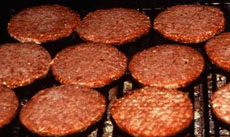 Prepared by
Diane Ball Linder, EdD, RD, LDN
All of the nutrients that give us energy such as protein,
carbohydrates and fat are made up of carbon, hydrogen and oxygen. But only proteins have
nitrogen. This makes the structure and role in health special. Nitrogen is essential for
life.
|
|
Click here for the printable (Word) version of the lesson
Protein
Introduction
 What do you
think of when you hear the word protein? Meat? Beans? Strong? Life? Many people think of
muscle and fitness. Protein does have something to do with life and vitality, because
protein is a necessary component of every cell. Protein is necessary for a person to grow
to his or her potential and to fight infection and disease. What do you
think of when you hear the word protein? Meat? Beans? Strong? Life? Many people think of
muscle and fitness. Protein does have something to do with life and vitality, because
protein is a necessary component of every cell. Protein is necessary for a person to grow
to his or her potential and to fight infection and disease.
You are looking at a package of proteins when you look in a mirror. All the parts of
your body that you see are made up of protein, even the inside parts of your body that you
can't see. Genes, hormones and enzymes are also proteins.
 The Greek
word protein means first place. Sometimes we place a lot of importance on protein over the
other two classes of nutrients that give us energy - carbohydrates and fat. We may have
grown up thinking that a meal isn't a meal unless it includes some meat. In planning our
meals, we might first think of what meat we will have and then select other foods to go
with it. However, we now know that we need to plan our meals in reverse - plan a meal to
include complex carbohydrates, such as, whole-grain breads and cereals, vegetables, fruit,
milk and then maybe add a little meat A healthy diet is based on foods that come from
plants, and we need to add a little animal products to round out our diets. The Greek
word protein means first place. Sometimes we place a lot of importance on protein over the
other two classes of nutrients that give us energy - carbohydrates and fat. We may have
grown up thinking that a meal isn't a meal unless it includes some meat. In planning our
meals, we might first think of what meat we will have and then select other foods to go
with it. However, we now know that we need to plan our meals in reverse - plan a meal to
include complex carbohydrates, such as, whole-grain breads and cereals, vegetables, fruit,
milk and then maybe add a little meat A healthy diet is based on foods that come from
plants, and we need to add a little animal products to round out our diets.
There are many different kinds of protein. It is not just one substance. All of the
nutrients that give us energy such as protein, carbohydrates and fat are made up of
carbon, hydrogen and oxygen. But only proteins have nitrogen. This makes the structure and
role in health special. Nitrogen is essential for life.
Food Guide Pyramid
Review:
The USDA Department of Agriculture developed the Food Guide Pyramid to help you see
what food you and your family should eat each day for good health. Foods that make
similar nutritional contributions are grouped into basic food groups. The pyramid also
lets you know how many servings of each of the food groups are needed each day. Eat some
food from each of the basic food groups in the pyramid and eat the recommended number of
servings.
The pyramid is based on getting the greatest number of servings from plant foods -
bread and cereals, vegetables and fruits. Food groups based on animal products are toward
the top - the milk and the meat food groups. Although animal products make important
contributions to our diet, we need to eat the recommended number of servings daily and
also make lower fat choices to avoid getting too much saturated fat in our diet. We need
to eat a little meat with a lot of plant foods. Selecting plant foods high in protein is
healthful.
Activity:
Look at the Food Guide Pyramid and write down the name of foods that give you protein
in as many basic food groups as you can.
What You Will
Learn:
In this lesson, you will learn that protein is a nutrient. You will learn about
how it is put together (structure) and what the functions of protein are. You will
learn which foods provide protein, including animal and plant foods, and which foods are
the best sources of protein for your body. With this information, you will be able
to decide which foods will be the best sources of protein for your family.
What is protein?
Protein is one of the three macronutrients that your body needs for survival.
Macronutrients are nutrients our bodies need in large amounts. The other two
macronutrients are carbohydrates and fat. Proteins supply the same amount of energy as
carbohydrates. One gram of protein gives about 4 calories when it is combined with oxygen
in the body. The body's primary need is for energy. It will ignore the special functions
of protein if it needs energy and no other source is available. However, we don't want our
body to have to rely on protein for energy. It needs to be used for important body
building, repair and maintenance work Getting the amount of carbohydrates we need is
important in order that protein won't be used as a source of energy.
 Issued in furtherance of Cooperative Extension
work, Acts of Congress of May 8 and June 30, 1914, in cooperation with the United States
Department of Agriculture. The Louisiana Cooperative Extension Service provides equal
opportunities in programs and employment. Information and Graphics on this site are
copyright protected by LSU Agricultural Center's Louisiana Issued in furtherance of Cooperative Extension
work, Acts of Congress of May 8 and June 30, 1914, in cooperation with the United States
Department of Agriculture. The Louisiana Cooperative Extension Service provides equal
opportunities in programs and employment. Information and Graphics on this site are
copyright protected by LSU Agricultural Center's Louisiana
Cooperative Extension Services.
For more information on the EFNEP program, contact EFNEPMail@agcenter.lsu.edu. |